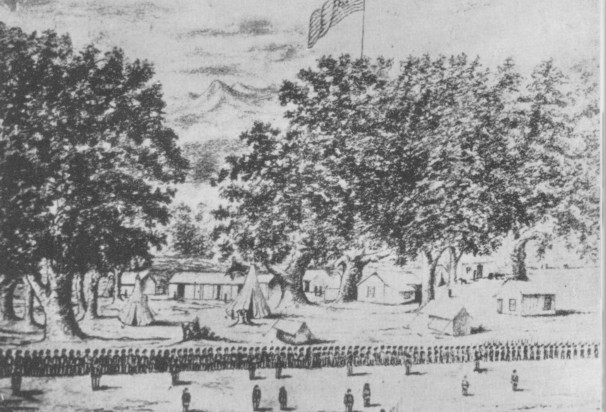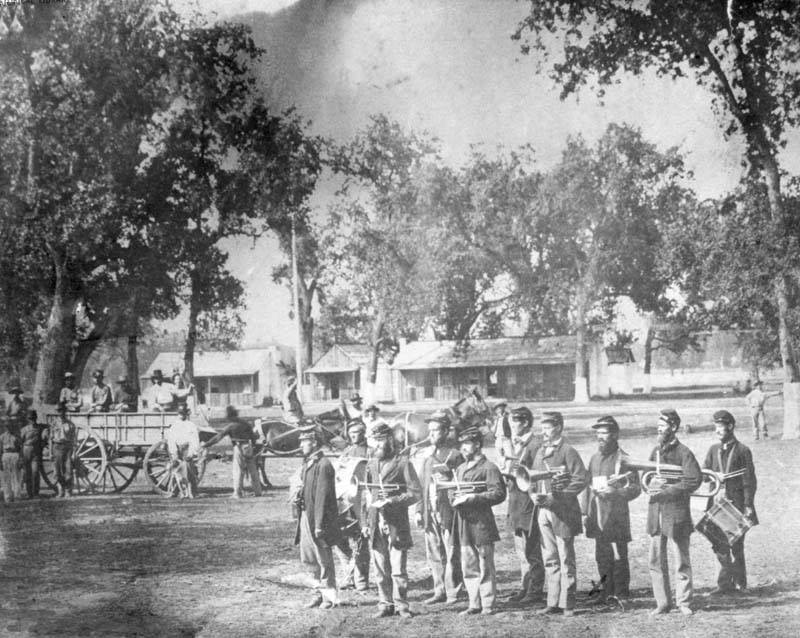
Established on June 24,
1862, by two companies of the 2nd California Cavalry, one mile
from the town of Visalia, Tulare County, the post was intended
to maintain order in the
area where rabid pro Confederate partisans were creating unrest.
The garrison was also engaged in, putting down Indian uprisings
in the Owens
River Valley. The
post was named for Lieutenant Colonel E. B. Babbitt, Quartermaster
General of the Pacific. On October 2. 1865, the post was relocated
about a mile northeast of its first site. Various dates have been
given for its abandonment, from late in 1865 to August 19, 1866.
Secessionists were so active in 1862, "It is an everyday occurrence for them to ride through the streets of Visalia and hurrah for Jeff Davis and Stonewall Jackson, and often give groans for the Stars and Stripes," reported Camp Babbitt's first commander, Lieutenant Colonel George S. Evans.
He told departmental headquarters, "They do and say everything in the presence of soldiers to insult them by calling them Lincoln hirelings, and that they bear Abe Lincoln's livery, etc., and in one instance have gone so far as to draw a pistol and present it at a soldier, telling that be bad a good mind to shoot the buttons off of his coat, just for fun."
His report cited several examples, including the killing of a soldier, and predicted that if the disloyal elements were not controlled, "all the officers between here and the Potomac, in my humble opinion, cannot prevent frequent collisions between the soldiers and the citizens, the ultimate result of which will be civil war."
Headquarters reacted promptly. "Under no circumstances will disloyal citizens be permitted to harass your troops or speak disrespectfully of our government," Evans was instructed. "If necessary to check conduct so unworthy of those seeking the protection of the government, you will arrest a few of the worst, holding them in close confinement, sending the leaders, if men of position, to Alcatraz Island."
Backing up the orders, headquarters rushed a company of California Volunteers to reinforce the post, even though the original garrison bad only been there two months. The reputation of Visalia was well known, and the Army decided that immediate action was necessary.
Secession had been rife in this Joaquin Valley region as early as the 1850's when the citizens threatened to form their own republic if not granted a railroad line. In 1860, editors of the rival Union and rebel newspapers met for a duel, but tempers were so short that what was to be a shooting match ended with principals and seconds trading punches. The editors themselves faced down each other in one of the newspaper offices a few days later. The secessionist editor took a fatal bullet in his stomach. The Union man decided his popularity had waned so much he had better leave town.
Visalia was suspected of being a stop on the underground to the south, a role proved when Federal marshals intercepted a courier in 1861. The next step, obviously was to send in troops.
In October 1862, Colonel Evans reported arriving at the site of Camp Babbitt after a forced march of 120 miles in four and-a-half days. The rigors of the march were obvious on the troopers, because the horses were too weak to carry burdens and, reported Evans, the men "were compelled to walk about two-thirds of the way, and that, too, barefooted and naked, for many of them were as destitute of shoes as they were the day they were born, and had no pantaloons, except such as they had themselves made out of barley and flour sacks . . . Still the men plodded on and stood guard at night, leaving the blood from their feet upon the rocks and snow."
Evans selected a campsite a mile north of the center of Visalia and in General Orders No. 13, dated October 31, 1862, announced, "This camp is hereby named and shall hereafter be known and called Camp Babbitt, in honor of Lieut. Col. E. B. Babbitt, Deputy Quartermaster General, U.S. Army, Department of the Pacific." Despite the high-sounding proclamation, the post was little more than a cluster of rude buts and tents amidst huge oak trees.
Captain Moses A. McLaughlin succeeded Evans and on December 21 reported, "This command does not number more than 100 effective men, and the rebels can bring against it 250 men in 24 hours, and 400 in two days, all of them well armed." He had arrested three persons "who had the audacity to ride and drive in front of the battalion while on dress parade, hurrahing for Jeff Davis and Stonewall Jackson."
McLaughlin refused to acknowledge a writ of habeas corpus for the release of the prisoners, and predicted "the sheriff will summon a strong posse comitatus, trying to regain them by force."
Some of the dissension was quieted when the prisoners were released two weeks later after taking the oath of allegiance. One, the editor of the secessionist Equal Rights Expositor which had been banned from the mails, was kept in confinement when he balked at the oath.
In March 1863, troopers took the newspaper question in their own hands. Thirty descended on the print shop after tattoo roll-call, "completely wrecked the office . . . breaking the doors and windows of the building, breaking the press, and throwing the type, paper, ink, etc., in the street."
A patrol was rushed into town to keep order, but the unorthodox means took effect. Other than the killing of a soldier by a rebel five months later and a rumor that "an outbreak may be looked for at any moment," public displays of disloyalty ceased.
It may have been because the townspeople organized two Home Guard companies, "To protect ourselves against the soldiers who came to protect us," one wag remarked after the war, or because the government rushed a howitzer to Babbitt with the orders: "Maintain your position at all costs."
Or it may have been that increased Indian depredation, caused both Union and secession sides to bury their political differences to face the common foe.
Troops left the town site of Camp Babbitt in 1865 to put more space between themselves and townspeople. An 1864 killing of a civilian was over an age-old complaint: the citizen was stealing drinks. Although first post had become a social center, especially with the lure of blue uniforms on parade and at the periodic "grand balls," townspeople did not take kindly when the men practiced roping on the headstones in the town cemetery during cavalry drills. After the secession business had died down, the newspaper commented, "No big drunks have occurred, no shootings, Oh, how dull." The shooting of a soldier by another caused the newspaper to suggest the men be prohibited from carrying weapons off of the post because they were no longer needed. By 1866, this was obvious and the post was abandoned.
TO GET THERE: Original Camp
Babbitt site is occupied by the Visalia ice plant with a sign
at the corner of Race and Santa Fe Streets in Visalia. The second
site is unmarked in the vicinity of Ben Maddox Way and Houston
Avenue.

Camp Babbitt in 1864 was sketched by Private George E. Young. By this time, troopers were preoccupied with Indian fighting, Babbitt's major action brought little credit to its California Volunteers when in 1863 they surrounded in Indian camp and, after settlers had identified 35 possible horse thieves "for whom no one would vouch" they were "either shot or sabered," reported Captain Moses A. McLaughlin. "Their only chance for life being their fleetness, but none escaped, though many of them fought well with knives, sticks, stones, and clubs. This extreme punishment, though I regret it, was necessary, and I feel certain that a few such examples will soon crush the Indians and finish the war in this and adjacent valleys."

An impromptu band of Camp
Babbitt (circa 1862) probably provided entertainment of a sorts
when it paraded at first site of post. Although some loyal townswomen
organized a "Visalia Sanitary Association;' as a forerunner
of the Red Cross and provided food and entertainment for the bored
troopers, usually they had to fend for themselves. Only one saloon
in town welcomed them, an emporium operated by a Mexican War veteran.
When they took their trade to the "Fashion" saloon and
refused to pay for the drinks, they took offense when the bartender
would not allow them cigars on the cuff, too. One soldier was
- fatally shot and another wounded in the events that followed.
Forty armed secessionists patrolled the streets the next day to
prevent further trouble, although the Army bad confined the soldiers
to quarters and promised to punish the guilty ones. They quickly
vanished when the commanding officer announced he would not require
his men to endure insults without retaliation, and hinted that
unless the vigilantes disbanded, lie would turn his men loose
on them.